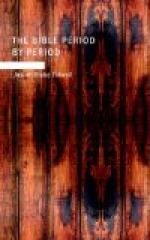Moses task was three fold: (1) Religious: He was to show in Egypt weakness of the idolatrous worship and to establish in the wilderness the true worship of one and only God who is ruler of all. (2) Political: He was to overcome the power of the mighty Pharaoh and deliver a people of 600,000 men besides the children with their herds and flocks out of his territory. Then, too, he was to give them laws and so connect them together that as a nation they would survive the hostile nations around them and the civil strife and dissensions within. (3) Social: He was also called upon to provide rules by which, to keep clean not only the individual, but his family, and to teach them right relations to each other. In carrying out this program, it devolved upon him to provide an elaborate code of civil, sanitary, ceremonial, moral and religious laws.
The Great Deliverance. The deliverance may be properly considered in three sections. (1) The preparation. (2) The contest with Pharoah and the ten plagues. (3) The crossing of the Red Sea.
The preparation consists (1) in getting the people acquainted with what God intended to do and thereby secure their full consent to enter into the plan. Then, too, it was necessary to have a very thorough organization so that the expedition could proceed in an orderly way. (2) There were various preliminary appeals to Pharaoh with the consequent added burdens laid upon the Hebrews.
The contest with Pharaoh consisted of certain preliminary demands followed by ten national calamities intended to force the king to let the people go. The struggle was all based upon the request of Moses that all Israel be allowed to go three days’ journey into the wilderness to serve their God. This gave the conflict a religious aspect and showed that the struggle was not merely one between Moses and Pharaoh, but between the God of Israel and the gods of Egypt.
All the plagues, therefore, had a distinct religious significance: (1) To show them the power of Jehovah (Ex. 7:17); (2) to execute judgment against the gods of Egypt (Ex. 12:12). Every plague was calculated to frustrate Egyptian worship or humiliate some Egyptian god. For example, the lice covered everything and were miserably polluting. All Egyptian worship was compelled to cease, since none of the priests could perform their religious service so long as any such insect had touched them since they went through a process of purification. In smiting the cattle with murrain, the sacred bull of Memphis was humiliated whether stricken himself or because of his inability to protect the rest of the cattle.




